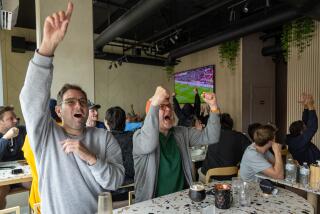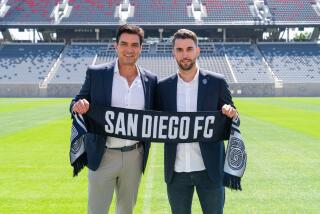SPECIAL REPORT / SOCCER IN AMERICA : World Cup Fever Working Against Established APSL : Competition: League has been around since 1990, but MLS threatens to shunt it aside.
Soccer people are quick to tell you that the successful run of the World Cup means big-time U.S. professional soccer is in the on-deck circle.
They’re sure of this because Alan Rothenberg, president of the U.S. Soccer Federation and chairman of the organization that ran the World Cup, is also in charge of Major League Soccer, the league he says will start next year.
One problem here.
The United States already has pro soccer.
It’s called the American Professional Soccer League and it has two key elements Rothenberg doesn’t--players and stadiums.
The league has been in business since 1990, has eight franchises, and is adding four for the 1995 season. Seven players on the U.S. World Cup team were APSL veterans.
The World Cup hasn’t benefited the APSL in the way league officials figured it would when the United States began preparing a few years ago for the world’s biggest sports event.
“At one time, we thought having the World Cup in the U.S. would be the greatest thing that could possibly happen to us,” said William De La Pena, APSL chairman and owner of the Los Angeles Salsa, which plays at Cal State Fullerton.
“We thought it would be a great shot in the arm for our league and the growth of soccer, but the way it’s worked out . . . “
The way it has worked out is that for the APSL, the World Cup was a nightmare--a colossus that generated revenue that might be used to bury the APSL.
*
Background: Alan Rothenberg has taken over U.S. soccer.
First, he was elected USSF president in 1990, and had himself put in charge of World Cup USA ‘94, the organization formed to run the event when FIFA, the sport’s world governing body, awarded it to the United States in 1988.
Then the USSF designated Rothenberg’s proposed league as the only Division I soccer league in the United States, infuriating APSL officials, who also had sought that designation.
Next, Rothenberg set up the U.S. Soccer Foundation, into which World Cup profits will be directed. Rothenberg has said 30% of the profits will be seed money for his pro league.
That could be about $6 million, since he said the tournament would have about a $20-million surplus.
While Rothenberg was building his power base, the APSL was quietly building its league.
“We have the best players in the country under long-term contracts,” said De La Pena, 40, who operates five ophthalmology clinics in Los Angeles and Orange counties.
“Two things are going to happen. There will only be the APSL playing next year, or we will have two leagues playing against each other. If that happens, we wish Rothenberg well.
“We have nothing personal against Rothenberg--we just feel the U.S. Soccer Federation should negotiate with us, too.”
Says another APSL owner, Martin Nixdorf of the Colorado Foxes, “I think Rothenberg would like to put us out of business, but I don’t know yet how he plans to do that.”
Rothenberg, through a spokesman, said he would have no comment.
Besides the Salsa and Colorado, the APSL has franchises in Ft. Lauderdale, Fla.; Houston, Montreal, Seattle, Toronto and Vancouver. Four more will be added next year, among them Detroit.
APSL players earn salaries of $30,000-$60,000. This year, each team plays a 20-game schedule that began recently and runs to late September. League venues range from 6,000 to 76,000 seats. MLS play, Rothenberg says, begins in April, 1995.
The Salsa, De La Pena’s team, plays in 10,000-seat Cal State Fullerton stadium considered to be the best for soccer in Southern California. The team said it averaged 5,367 a home date last season.
Last spring, Rothenberg’s representatives visited Cal State Fullerton, asking to inspect the stadium. De La Pena is still annoyed.
“They knew when they went down there we had a five-year exclusive lease on that facility,” De La Pena said.
Said Bill Shumard, former Cal State Fullerton athletic director, “They pushed pretty hard. They promised to enlarge it by 20,000 seats. They wanted the school to break the lease, and we told them we weren’t about to.”
So, where is all this headed?
A soccer war, akin to the old NFL-AFL war of the 1960s? The courtroom? A merger? A takeover?
“The only way Rothenberg can start a league that’s comparable to ours in quality is if he brings in a lot of foreign players,” said Alan Hinton, president and coach of the Seattle Sounders.
The APSL permits only two foreign players on each team’s 18-player game-day roster. Rothenberg has said the MLS will allow four foreigners per team.
“When all the dust settles, this will be all about players,” Hinton said.
“My sincere hope is that we can all sit down around a table and sort all this out and do what’s right for American soccer.”
Said De La Pena, “Until Rothenberg came along, we were the only ones laying out money for U.S. pro soccer. Suddenly, here is Rothenberg with his league, backed by World Cup money . . . and all under the auspices of the U.S. Soccer Federation.”







